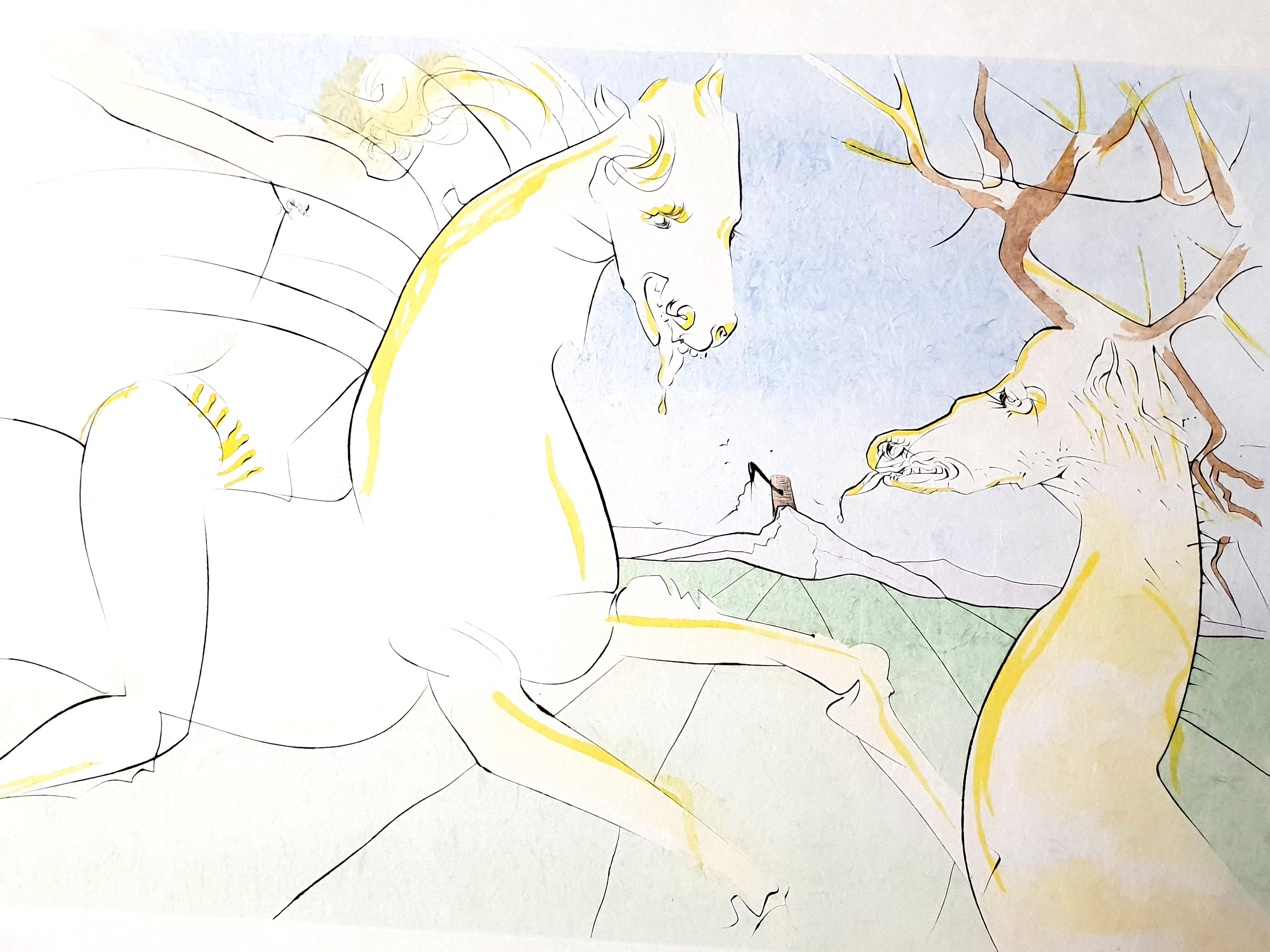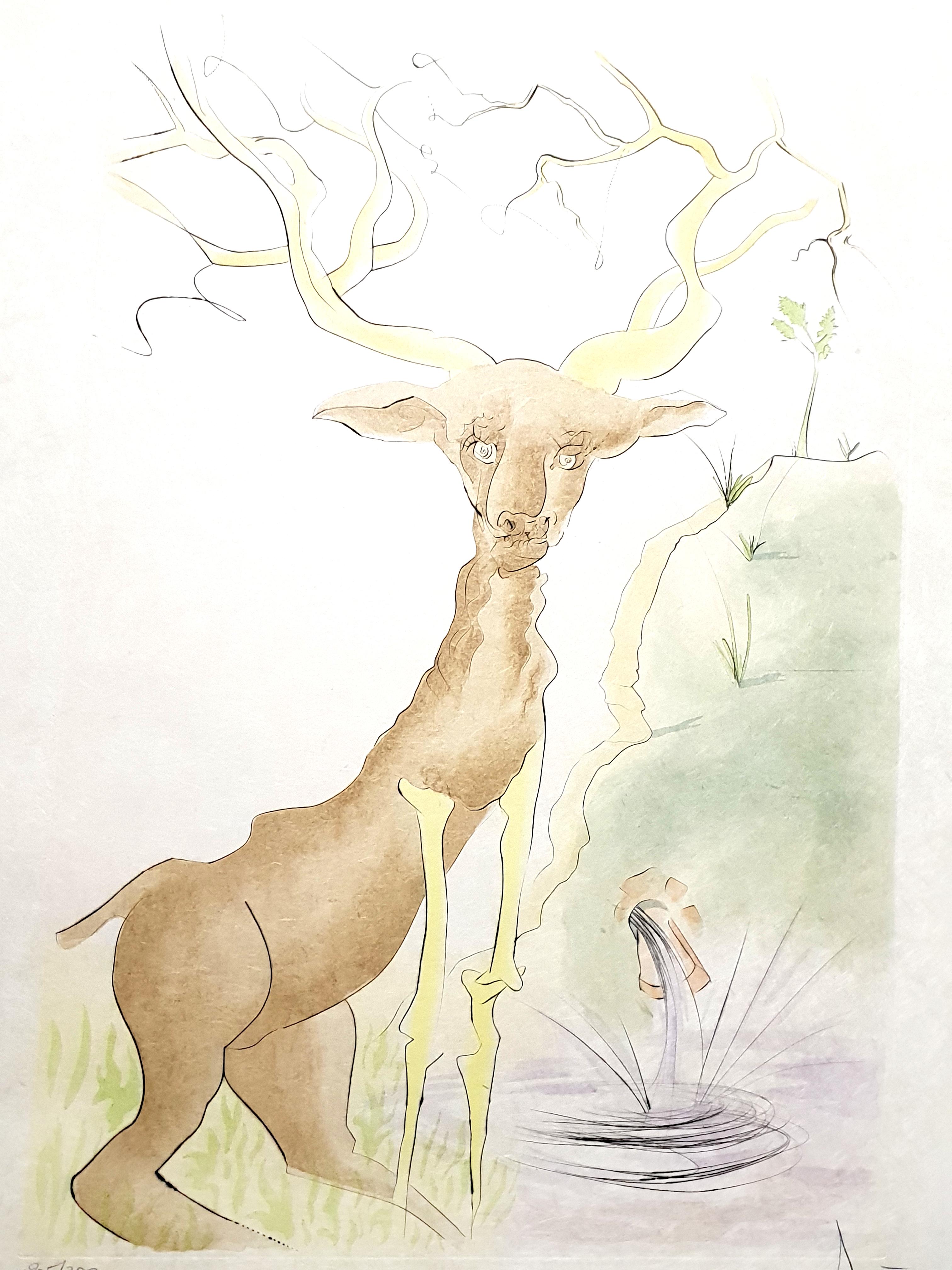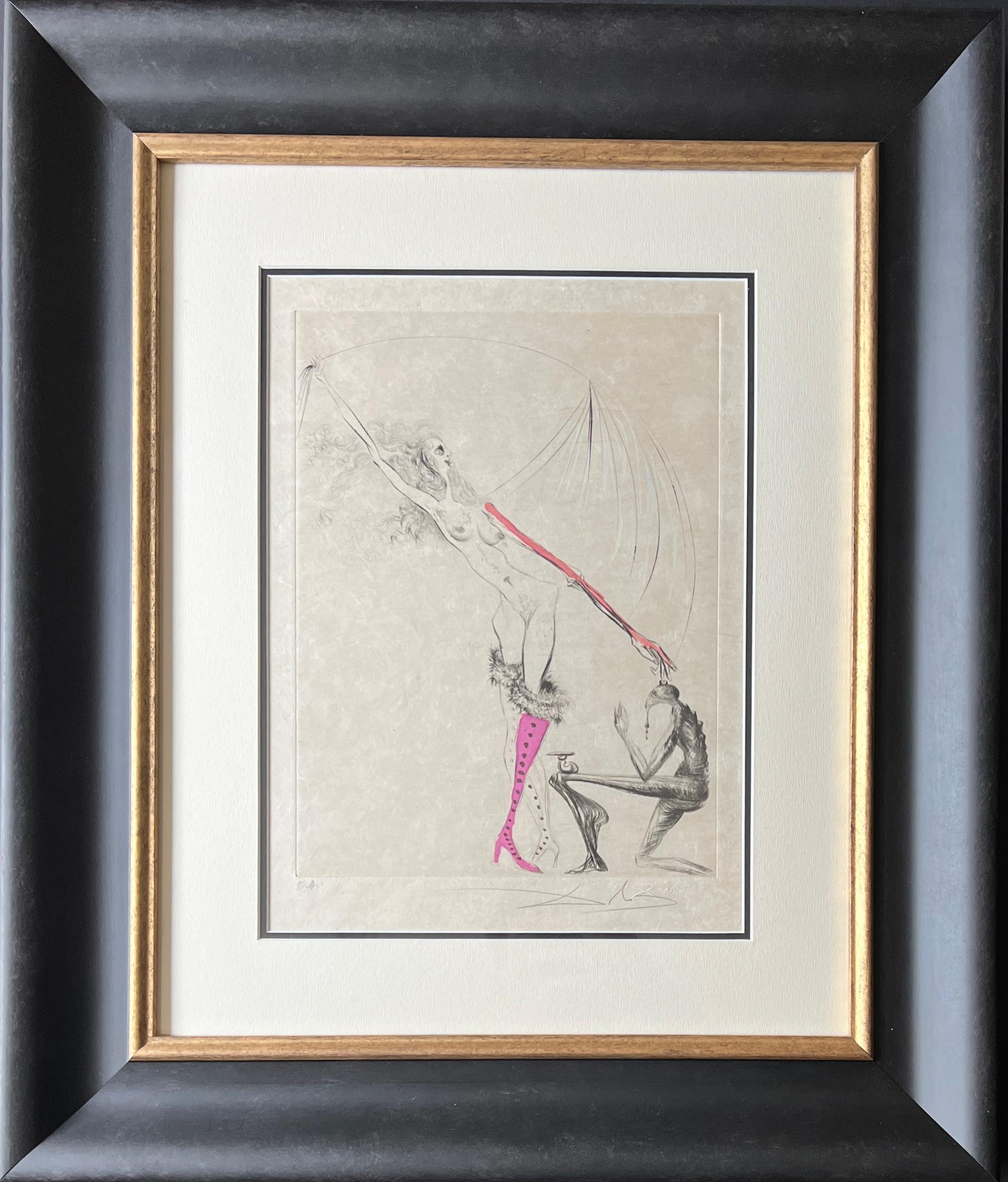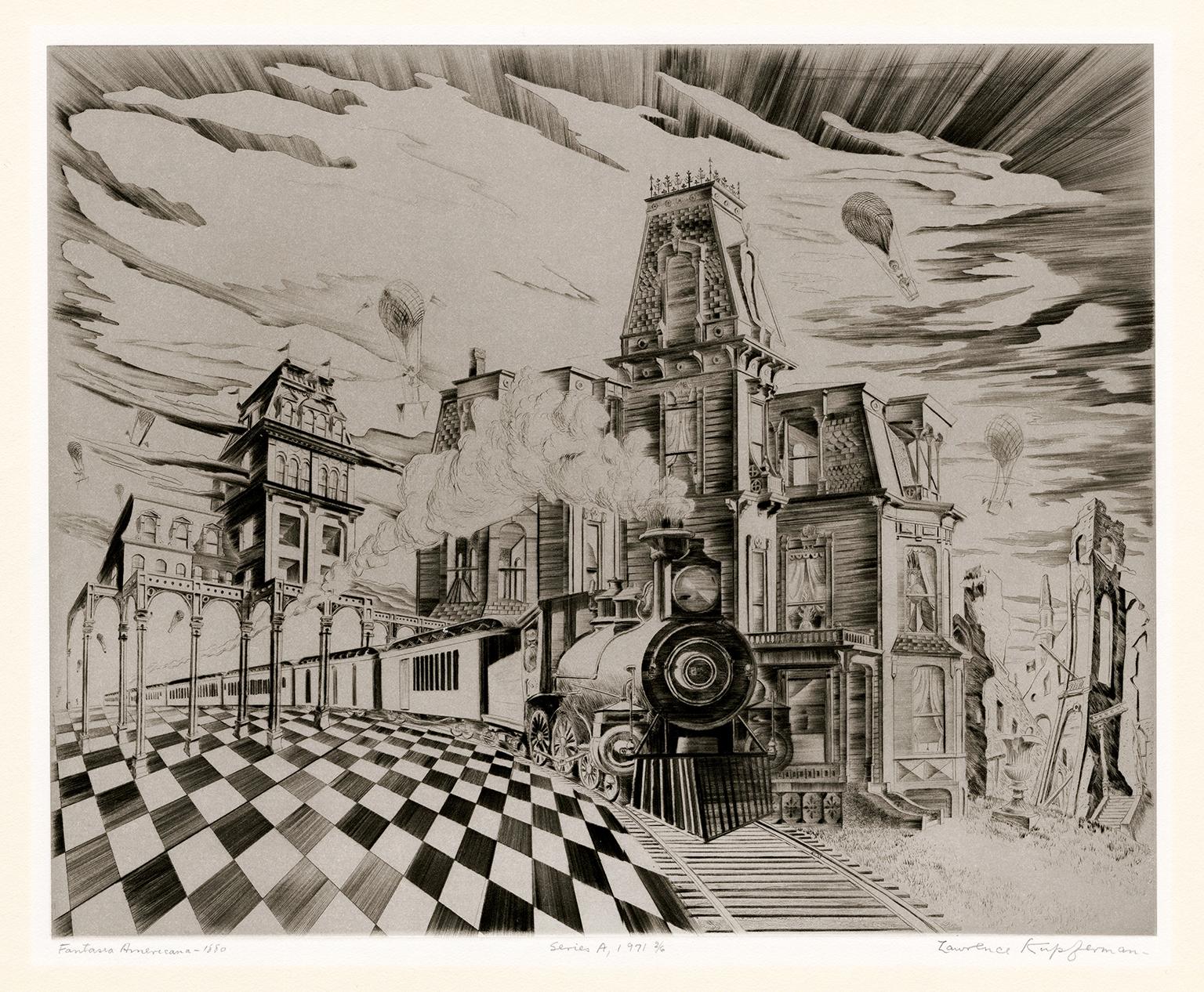Marc ChagallThe Automobilist, from: My Life - Russian French Berlin Autobiography Surrealism
About the Item
- Creator:Marc Chagall (1887 - 1985, French)
- Dimensions:Height: 13.86 in (35.2 cm)Width: 10.67 in (27.1 cm)
- More Editions & Sizes:Edition of 110Price: $7,000
- Medium:
- Movement & Style:
- Period:
- Condition:
- Gallery Location:London, GB
- Reference Number:1stDibs: LU18013269492
Marc Chagall
Described by art critic Robert Hughes as "the quintessential Jewish artist of the twentieth century," the Russian-French modernist Marc Chagall worked in nearly every artistic medium. Influenced by Symbolism, Fauvism, Cubism and Surrealism, he developed his own distinctive style, combining avant-garde techniques and motifs with elements drawn from Eastern European Jewish folk art.
Born Moishe Segal in 1887, in Belarus (then part of the Russian empire), Chagall is often celebrated for his figurative paintings, but he also produced stained-glass windows for the cathedrals of Reims and Metz, in France; for the United Nations, in New York; and for the Hadassah Hospital in Jerusalem, as well as book illustrations, stage sets, ceramics, tapestries and fine-art prints. Characterized by a bold color palette and whimsical imagery, his works are often narrative, depicting small-village scenes and quotidian moments of peasant life, as in his late painting The Flight into Egypt from 1980.
Before World War I, Chagall traveled between St. Petersburg, Paris and Berlin. When the conflict broke out, he returned to Soviet-occupied Belarus, where he founded the Vitebsk Arts College before leaving again for Paris in 1922. He fled to the United States during World War II but in 1947 returned to France, where he spent the rest of his life. His peripatetic career left its mark on his style, which was distinctly international, incorporating elements from each of the cultures he experienced.
Marc Chagall remains one of the past century’s most respected talents — find his art on 1stDibs.
- ShippingRetrieving quote...Ships From: London, United Kingdom
- Return PolicyA return for this item may be initiated within 3 days of delivery.
- In the Café - German Impressionism Berlin Society Cafe SceneBy Lesser UryLocated in London, GBThis original etching and drypoint is hand signed in pencil by the artist "L. Ury" at the lower left margin. It was published in an edition of 110 hand signed impressions by Propyläe...Category
1920s Impressionist Figurative Prints
MaterialsDrypoint, Etching
- Lady Hailing a Carriage Dame, eine Droschke rufend - German ImpressionismBy Lesser UryLocated in London, GBThis original etching and drypoint is hand signed in pencil by the artist "L. Ury" at the lower left margin. It is also hand numbered in pencil from the edition of 150, at the lower ...Category
1910s Impressionist Figurative Prints
MaterialsDrypoint, Etching
- Monument to Christopher Columbus and Marcel Duchamp - 13 Etchings by ArtistsBy Joan MiróLocated in London, GBVARIOUS ARTISTS Title: Monument to Christopher Columbus and Marcel Duchamp Monument à Christophe Colomb et à Marcel Duchamp, 1971 Technique: Complete Set of Thirteen Original Ha...Category
1970s Surrealist Figurative Prints
MaterialsEtching
- Central Panel, from: Triptych 1974-1977By Francis BaconLocated in London, GBFRANCIS BACON 1909-1992 Dublin 1909-1992 Madrid (Irish/British) Title: Central Panel, from: Triptych 1974-1977, 1981 Technique: Original Hand Signed and Numbered Etching and Aquatint in Colours on Wove Paper Paper size: 64.8 x 50 cm. / 25.5 x 19.7 in. Image size: 38.8 x 29.5 cm. / 19.3 x 11.5 in. Additional Information: This etching and aquatint in colours is hand signed in pencil by the artist "Francis Bacon" in the lower right margin. It is also hand numbered in pencil from the edition of 99, in the lower left margin. The work was printed in a limited edition of 99 signed and numbered impressions with an additional 15 Hors Commerce [out of trade] impressions and 15 artist’s proofs. It was printed and published by Polígrafa, Barcelona in 1981. It is based on the painting of the same title. Note: Tryptic 1974-1977 is one of Bacon's finest triptychs. It was painted by Bacon between May and June 1974 and was made in response to the tragic death of his lover George Dyer in 1971. It was the last work the artist made before a major retrospective of his work held at the Metropolitan Museum of Art in New York in 1974. The exhibition formed the culmination of this important survey of Bacon's career from the late 1960s onwards and was immediately recognised as both a major landmark and also perhaps a turning point in Bacon's career. From 1971, Francis Bacon had been preoccupied with Dyer and the tragic manner of his suicide. Triptych 1974-77 also borrows several elements from the three earlier so-called 'Black' triptychs (In memory of George Dyer, 1971, Triptych August 1972 and Triptych May-June 1973). In each of these great three-panel paintings, the figure of Dyer is presented on the threshold of entering a dark void, either in the form of his hotel room, or silhouetted against a sequence of black rectangles. At the bottom of this central panel on a pale blue, purple and black curved continuation of this arena-like circle, there originally appeared a bizarre prone and bespectacled slug-like figure. Based on one of Edward Muybridge...Category
1980s Surrealist Figurative Prints
MaterialsAquatint, Etching
- Fraternity Fraternité - Portfolio with 9 Etchings by Kandinsky Miro HayterBy Wassily KandinskyLocated in London, GBVARIOUS ARTISTS Title: Fraternity Fraternité, 1939 Technique: Complete Set of Nine Original Hand Signed Etchings on Montval Wove Paper with the Accompanying Text and Portfolio Portfolio size: 24 x 17.5 x 2 cm. / 9.5 x 6.9 x 1 in. Additional information: Each of the works in the portfolio is hand signed in pencil by each artist. The portfolio is hand numbered in pencil “97” on the justification page. This portfolio was printed in the limited edition of 101 by Atelier 17 and Henri Hecht...Category
1930s Surrealist Figurative Prints
MaterialsEtching
- The Blue Dog - Etching with Aquatint - Spanish SurrealismBy (after) Joan MiróLocated in London, GBJOAN MIRO 1893-1983 Montroig 1893- 1983 Mallorca (Spanish) Title: The Blue Dog Le chien bleu, 1959 Technique: Hand Signed and Numbered Etching with Aqu...Category
1950s Surrealist Figurative Prints
MaterialsEtching, Aquatint
- La Tombe du Père - Etching by Marc Chagall - 1923By Marc ChagallLocated in Roma, ITLa Tombe du Pére or The Father's Grave is a wonderful and rare dry-point, hand-signed in pencil on the lower right margin and hand-numbered on the lower left margin by Marc Chagall. ...Category
1920s Surrealist Figurative Prints
MaterialsDrypoint, Etching
- Salvador Dali - The Rider and the Deer - Handsigned EngravingBy Salvador DalíLocated in Collonge Bellerive, Geneve, CHSalvador Dali - The Rider and the Deer - Handsigned Engraving 1974 Hand signed by Dali Edition: /250 The dimensions of the image are 22.8 x 15.7 inches on 3...Category
1970s Surrealist Figurative Prints
MaterialsDrypoint, Aquatint
- Salvador Dali - Le Cerf from Le Bestiaire de la Fontaine - Signed EngravingBy Salvador DalíLocated in Collonge Bellerive, Geneve, CHSALVADOR DALI Le Cerf se voyant dans l'eau from Le Bestiaire de la Fontaine 1974 Hand signed by Dali Edition: /250 The dimensions of the image are 22.8 x 15.7 inches on 31 x 23.2 in...Category
1970s Surrealist Figurative Prints
MaterialsDrypoint, Aquatint
- Salvador Dalí – La Botte violette – hand watercolored drypoint etching – 1969By Salvador DalíLocated in Varese, IThand watercolored drypoint etching on extremely fine Japanese paper, edited in 1969 limited edition of 145 copies water-colored , numbered in lower left corner ea ( artist proof ) si...Category
1960s Surrealist Figurative Prints
MaterialsWatercolor, Paper, Drypoint, Etching
- Surrealist Salvador Dali Large Pochoir Etching Drypoint Lithograph Chariot RiderBy Salvador DalíLocated in Surfside, FLSalvador Dalí (1904-1989) – Spanish painter, graphic artist and sculptor. Drypoint with etching and pochoir on Japon paper "Elijah and the Chariot," 1975, (Horse and rider) from the "Our Historical Heritage" suite. Pencil signed along the lower right and numbered 53/250 along the lower left. Literature: Field 75-4 J Framed; Height: 29 in x width: 35 in. Mat opening 19.5 X 25.5. The Spanish artist’s extensive oeuvre not only includes watercolors, drawings and sculptures but also tapestries; here a fine example from the limited edition ‘The Twelve Tribes of Israel’ The tapestry was created after an etching by Salvador Dalí from 1973 with the title ‘The Tribe of Judah’, which the artist created as part of a suite to mark the 25th anniversary of the State of Israel, and in which he represented the twelve tribes of Israel. This vintage French tapestry is an impeccable textile re-creation of a rare Dali etching. This is a flat weave Aubusson style tapisserie. The edition size was 500. The tapestry is inscribed with woven ‘Salvador Dalí’ lower right Genre: Surrealism Subject: people, architecture rendering Medium: textile Salvador Dali (Spanish, 1904-1989) Salvador Dali is considered as the greatest original artist of the surrealist art movement and one of the greatest masters of art of the twentieth century. Dali began to study art at the Royal Academy of Art in Madrid. He was expelled twice and never took the final examinations. His opinion was that he was more qualified than those who should have examined him. In 1928 Dali went to Paris where he met the Spanish painters Pablo Picasso and Joan Miro. He established himself as the principal figure of a group of surrealist artists grouped around Andre Breton, who was something like the theoretical "schoolmaster" of surrealism. Years later Breton turned away from Dali accusing him of support of fascism, excessive self-presentation and financial greediness. By 1929 Dali had found his personal style that should make him famous - the world of the unconscious that is recalled during our dreams. The surrealist theory is based on the theories of the psychologist Dr. Sigmund Freud. Recurring images of burning giraffes and melting watches became the artist's surrealist trademarks. Along with Rene Magritte his is considered the greatest of the Surrealists. His great craftsmanship allowed him to execute his paintings in a nearly photo realistic style. No wonder that the artist was a great admirer of the vintage Italian Renaissance painter Raphael. Meeting Gala was the most important event in the artist's life and decisive for his future career. She was a Russian immigrant and ten years older than Dali. When he met her, she was married to Paul Eluard. In 1933 Salvador Dali had his first one-man show in New York. One year later he visited the U.S. for the first time supported by a loan of US$500 from Pablo Picasso. To evade World War II, Dali chose the U.S.A. as his permanent residence in 1940. He had a series of spectacular exhibitions, among others a great retrospective at the Museum of Modern Art in New York. He has worked in paining, sculpture, tapestry, Daum glass and prints. Dali became the darling of the American High Society. Celebrities like Jack Warner or Helena Rubinstein gave him commissions for portraits. His artworks became a popular trademark and besides painting he pursued other activities - jewelry and dated clothing designs for Coco Chanel or film making with Alfred Hitchcock. In 1948 Dali and Gala returned to Europe, spending most of their time either in their residence in Ligate/Spain or in Paris/France or in New York. Dali developed a lively interest in science, religion and history. He integrated things into his art that he had picked up from popular science...Category
1970s Surrealist Figurative Prints
MaterialsDrypoint, Etching, Lithograph
- 'Fantasia Americana - 1880' — Mid-Century American SurrealismBy Lawrence KupfermanLocated in Myrtle Beach, SCLawrence Kupferman, 'Fantasia Americana – 1880', drypoint etching with sandground, 1943. Signed, titled, and annotated 'Series A, 1971 2/6' in pencil. A superb, richly-inked impression, on heavy, cream wove paper, with full margins (2 1/2 to 3 1/2 inches); the paper slightly lightened within the original mat opening, otherwise in excellent condition. One of only 6 impressions printed in 1971, with the added sandground grey background tint. Image size 11 13/16 x 14 3/4 inches; sheet size 18 x 20 1/4 inches. Archivally matted to museum standards, unframed. Collections: National Gallery of Art, Zimmerli Art Museum (Rutgers University). ABOUT THE ARTIST Lawrence Kupferman (1909 - 1982) was born in the Dorchester neighborhood of Boston and grew up in a working-class family. He attended the Boston Latin School and participated in the high school art program at the Museum of Fine Arts, Boston. In the late 1920s, he studied drawing under Philip Leslie Hale at the Museum School—an experience he called 'stultifying and repressive'. In 1932 he transferred to the Massachusetts College of Art, where he first met his wife, the artist Ruth Cobb. He returned briefly to the Museum School in 1946 to study with the influential expressionist German-American painter Karl Zerbe. Kupferman held various jobs while pursuing his artistic career, including two years as a security guard at the Museum of Fine Arts, Boston. During the 1930s he worked as a drypoint etcher for the Federal Art Project, creating architectural drawings in a formally realistic style—these works are held in the collections of the Fogg Museum and the Smithsonian American Art Museum. In the 1940s he began incorporating more expressionistic forms into his paintings as he became progressively more concerned with abstraction. In 1946 he began spending summers in Provincetown, Massachusetts, where he met and was influenced by Mark Rothko, Hans Hofmann, Jackson Pollock, and other abstract painters. At about the same time he began exhibiting his work at the Boris Mirski Gallery in Boston. In 1948, Kupferman was at the center of a controversy involving hundreds of Boston-area artists. In February of that year, the Boston Institute of Modern Art issued a manifesto titled 'Modern Art and the American Public' decrying 'the excesses of modern art,' and announced that it was changing its name to the Institute of Contemporary Art (ICA). The poorly conceived statement, intended to distinguish Boston's art scene from that of New York, was widely perceived as an attack on modernism. In protest, Boston artists such as Karl Zerbe, Jack Levine, and David Aronson formed the 'Modern Artists Group' and organized a mass meeting. On March 21, 300 artists, students, and other supporters met at the Old South Meeting House and demanded that the ICA retract its statement. Kupferman chaired the meeting and read this statement to the press: “The recent manifesto of the Institute is a fatuous declaration which misinforms and misleads the public concerning the integrity and intention of the modern artist. By arrogating to itself the privilege of telling the artists what art should be, the Institute runs counter to the original purposes of this organization whose function was to encourage and to assimilate contemporary innovation.” The other speakers were Karl Knaths...Category
1940s Surrealist Figurative Prints
MaterialsDrypoint, Etching






